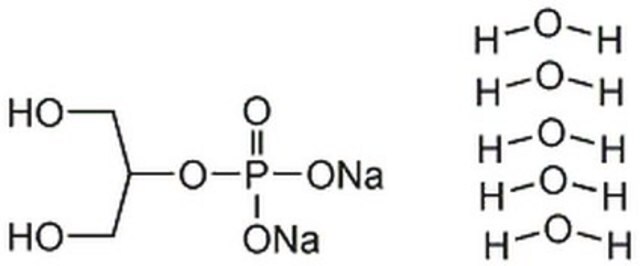524627
Phosphatase Inhibitor Cocktail III
liquid, for the inhibition of serine/threonine and protein tyrosine phosphatases
Synonym(e):
Phosphataseinhibitor-Mix (Set III)
About This Item
Empfohlene Produkte
product name
Phosphatase-Inhibitor-Cocktail Set III, Phosphatase Inhibitor Cocktail Set III is a ready to use cocktail of four phosphatase inhibitors for broad-spectrum inhibition of both serine/threonine and protein tyrosine phosphatases.
Form
liquid
Hersteller/Markenname
Calbiochem®
Lagerbedingungen
OK to freeze
Versandbedingung
wet ice
Lagertemp.
−20°C
Allgemeine Beschreibung
Anwendung
- als Ergänzung in Lysepuffer zur Herstellung von Proteinlysaten ganzer Hoden für Western Blots
- zur Verstärkung eines eiskalten Lysepuffers für den Radioimmunpräzipitationsassay (RIPA) zur Homogenisierung von Enddärmen von Larven für Western-Blot-Analysen
- als Komponente im Zelllysepuffer zur Extraktion von Gesamtproteinen für Western Blots
Biochem./physiol. Wirkung
Serin-/Threonin- und Protein-Tyrosin-Phosphatasen
Leistungsmerkmale und Vorteile
- Gebrauchsfertige Formulierungen für den bequemen Gebrauch
- Hochwertige Produkte für gleichbleibende und reproduzierbare Leistung
- Flexible Optionen mit einer Reihe von Cocktails, die auf verschiedene Kategorien von Phosphatasen ausgerichtet sind
Komponenten
- 50 mM Natriumfluorid
- 10 mM ß-Glycerophosphat (Art.-Nr. 35675)
- 10 mM Natriumpyrophosphat-Decahydrat
- 1 mM Natriumorthovanadat
Warnhinweis
Physikalische Form
Rekonstituierung
Sonstige Hinweise
Rechtliche Hinweise
Lagerklassenschlüssel
12 - Non Combustible Liquids
WGK
WGK 2
Flammpunkt (°F)
Not applicable
Flammpunkt (°C)
Not applicable
Analysenzertifikate (COA)
Suchen Sie nach Analysenzertifikate (COA), indem Sie die Lot-/Chargennummer des Produkts eingeben. Lot- und Chargennummern sind auf dem Produktetikett hinter den Wörtern ‘Lot’ oder ‘Batch’ (Lot oder Charge) zu finden.
Besitzen Sie dieses Produkt bereits?
In der Dokumentenbibliothek finden Sie die Dokumentation zu den Produkten, die Sie kürzlich erworben haben.
Kunden haben sich ebenfalls angesehen
Unser Team von Wissenschaftlern verfügt über Erfahrung in allen Forschungsbereichen einschließlich Life Science, Materialwissenschaften, chemischer Synthese, Chromatographie, Analytik und vielen mehr..
Setzen Sie sich mit dem technischen Dienst in Verbindung.













